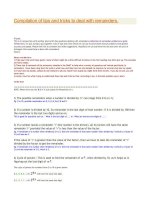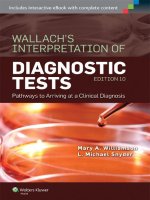Ebook Tips and tricks of bedside cardiology (first edition): Part 2
Bạn đang xem bản rút gọn của tài liệu. Xem và tải ngay bản đầy đủ của tài liệu tại đây (6.02 MB, 105 trang )
30
Case
Exertional Dyspnea,
Cyanosis and Fainting
Patient Profile
Age: 32
Sex: Female
Built: Lean
Chief Complaints
• Progressively increasing dyspnea on exertion for the last 1 year.
• Coldness of hands and blueness of fingers since 3 months.
• Fainting on 2 occasions in the preceding 1 month.
Relevant History
• There was no history of breath-holding spells or squatting episodes
during her early life.
• There was no history of recurrent sore throat, joint pains or prolonged
fever during childhood or adolescence.
• There was no history of fever, productive cough, chest pain or
hemoptysis preceding her recent worsening of symptoms.
• There was no history of palpitation and skipped beats or of orthopnea
and paroxysmal nocturnal dyspnea.
Physical Examination
•
•
•
•
•
No pallor or jaundice or ankle edema
Cyanosis and clubbing of the finger-nails
Pulse: 88 BP: 104/ 70 Temp.: 98 Resp.: 24
Pulse: regular, low in volume and feeble
JVP: 5 cm above angle of Louis at 45 degrees
Prominent ‘a’ wave observed.
• CVS: Normal apex beat, sustained left parasternal heave
Systolic pulsations visible in the pulmonary area
S1 normal, P2 loud and audible upto the apex.
No S3 or S4 gallop sound heard
Gr II /VI soft systolic murmur adjacent to the sternum.
• Chest: clear on auscultation, no rhonchi or crepts.
118
Tips and Tricks of Bedside Cardiology
An ECG was obtained.
ECG Findings:
• Tall R wave in leads V1 to V3
• Deep S wave in leads V4 to V6
• Peaked P wave; P. pulmonale.
An X-RAY was also ordered.
X-RAY Findings:
• Right ventricular enlargement
Exertional Dyspnea, Cyanosis and Fainting
119
• Prominent pulmonary artery
• Normal pulmonary vasculature.
Diagnosis
PRIMARY PULMONARY HYPERTENSION
Discussion
• A history of progressively increasing dyspnea on exertion raises the
possibilities of chronic pulmonary disease, congenital or valvular heart
disease, cardiomyopathy or pulmonary hypertension. If there is
additional history of syncopal episodes, outflow obstruction due to
mitral stenosis, aortic stenosis, hypertrophic subaortic stenosis or
pulmonary arterial hypertension should be considered.
• Causes of pulmonary hypertension are:
–
Increased pulmonary flow
lt. to rt. shunt; ASD, VSD, PDA
–
Raised left atrial pressure
mitral valve disease, LV dysfunction
–
Chronic pulmonary disease
bronchitis, emphysema, fibrosis
–
Obstruction to pulmonary flow
thromboembolic, veno occlusive
–
Primary pulmonary hypertension.
• In pulmonary hypertension due to Eisenmenger complex with left- toright shunt, chest X-ray features are RV hypertrophy, prominent
pulmonary artery and increased pulmonary blood flow (pulmonary
plethora). In mitral valve disease, there is straightening of the left heart
120
Tips and Tricks of Bedside Cardiology
border due to prominent left atrial appendage. In chronic pulmonary
disease the bronchovascular markings are accentuated and there is
pulmonary emphysema.
Clinical Pearls
• The presence of cyanosis indicates the presence of chronic lung
disease or a right-to-left cardiac shunt. In primary pulmonary
hypertension, cyanosis is caused by right-to-left shunt across a patent
foramen ovale.
• A prominent ‘a’ wave in the jugular venous pulse indicates right atrial
contraction against a noncompliant hypertrophic right ventricle. It is
observed in both pulmonary stenosis as well as in pulmonary
hypertension.
• A sustained heave on palpation in the left parasternal area indicates
the presence of right ventricular hypertrophy. It is also observed in
pulmonary stenosis.
• A loud pulmonary component (P2) of the second heart sound (S2) is a
classical indicator of pulmonary hypertension. In pulmonary stenosis,
the P2 is muffled. The fact that the P2 is heard even at the cardiac apex is
in itself indicative of pulmonary hypertension.
• Prominent systolic pulsations felt with a soft systolic murmur heard in
the second left intercostal space adjacent to the sternum (pulmonary
area), indicates dilatation of the main pulmonary artery.
31
Case
Fever with Chills &
Petechial Spots
Patient Profile
Age: 48
Sex: Male
Built: Lean
Chief Complaints
• High grade fever with chills for the past 10 days.
• Malaise, arthralgias, anorexia and weight loss.
Relevant History
• Patient underwent aortic valve replacement for a stenotic aortic valve
with a St. Jude’s prosthesis, 6 months back.
• He recently underwent extraction of a carious tooth but failed to comply
with the antibiotic regimen prescribed by his dentist.
• There was no history of sore throat, joint swelling, productive cough,
burning micturition, pain abdomen or loose stools.
• There was also no past history of intravenous drug abuse, heavy
alcoholic intake or having undergone a genitourinary procedure.
Physical Examination
•
•
•
•
•
•
•
Ill-looking, toxic, restless and tachypneic
Petechiae under finger-nails (Splinter hemorrhages)
Painful nodules on the finger-tips (Osler nodes)
Hemorrhages on thenar eminences (Janeway lesions)
Subconjunctival petechiae in both eyes (Roth spots)
Pulse: 104 BP: 110/ 60 Temp.: 100.8 Resp.: 24
CVS: Normal precordium, heaving apex beat
S1 loud, ejection click +, high pitched S2, no S3 sound
Gr II /VI ejection systolic murmur, left sternal border.
• Chest: normal sounds; no rhonchi or crepts
• Abdo.: no hepatosplenomegaly or ascites.
An ECHO was performed
122
Tips and Tricks of Bedside Cardiology
ECHO Finding:
• Nodular echo-reflective masses,
attached to the aortic leaflets.
Lab. Investigations
• Blood counts:
• Urinalysis:
• Biochemistry:
• Bacteriology:
Hb 8.8, TLC 13800, N83 L15, ESR 52
Albumin +, WBCs 2-3, RBCs ++
Glucose 78, Urea 32, Creatinine 1.1,
ASLO titer 220 IU, CRP level 80 mg/ L
Bilirubin 2.2, SGOT 42, SGPT 48
Cholesterol 178, LDL 110, TSH 2.2
Throat swab culture: no growth
Blood culture grew Streptococcus viridans
Fever with Chills & Petechial Spots 123
Diagnosis
AORTIC VALVE ENDOCARDITIS
Discussion
• Endocarditis is inflammation of the inner surface of the heart, including
the lining of heart valves. Inflammatory and infected material
accumulates to cause discrete lesions called vegetations. Vegetations
are made up of tissue debris fibrin, platelets and leukocytes.
• Endocarditis may be caused by an infective pathogen or due to a
noninfective disease:
Infective causes:
– Bacterial : Streptococcus, Staphylococcus
– Fungal : Aspergillus, Candida
– Others : Coxiella, Chlamydia
Noninfective causes
– Malignant disease : Marantic endocarditis
– Collagen disorder : Libman-Sacks endocarditis
– Rheumatic fever : Rheumatic pancarditis.
• On echo, vegetations appear as mobile, irregular echoreflective masses
attached to a valve cusp or a cardiac shunt. The valve may be native or
prosthetic and is usually a left- sided mitral or aortic valve.
• Vegetations vary in size from few mm to several cm. Those less than
2 mm in size are difficult to visualize. Large vegetations are associated
with fungal or tricuspid endocarditis. They shrink as they heal although
rapid shrinkage is indicative of embolization.
• Vegetations move in concert with the leaflet, and do not impair its
excursion. They may be sessile (nodular) or pedunculated and irregular
or smooth. Fresh vegetations are lumpy but they smoothen as they heal.
Fresh vegetations are isoechoic with the leaflet but they get brighter as
they heal.
124
Tips and Tricks of Bedside Cardiology
Clinical Pearls
• In the clinical setting of rapid onset of dyspnea and palpitation with a
febrile illness, an infectious process must be considered. Acute rheumatic
fever and subacute bacterial endocarditis are the main possibilities. An
acute viral pericarditis or myocarditis or pneumonitis must also be
excluded.
• The indications for performing serial echoes in endocarditis are:
– diagnosis of vegetations
– looking for complications
– detecting predisposing lesion
– evaluating response to treatment
– timing of surgical intervention.
• Endocarditis can lead to valve destruction, valvular regurgitation,
appearance of a new murmur or change in a preexisting murmur. This
occurs due to prolapse, perforation or rupture of a valve leaflet. There
can be abscess formation around a valve ring or in the interventricular
septum which can cause conduction block.
• Healed vegetations differ from fresh ones by being smaller, smoother
and hyperechoic. Shrinkage of vegetations alone does not indicate cure
while rapid shrinkage suggests embolization. Increase in vegetation size
indicates persistence of infection and ineffective antimicrobial therapy.
The risk of embolization persists for as long as 6 months even after
bacteriological cure.
• How often serial echos should be done while the patient is receiving
antibiotics is a matter of debate. It is difficult to justify frequent echos
unless this will clearly alter clinical decisions in management. However,
repeat echo should be definitely carried out if there is deterioration in
the patient’s clinical condition.
32
Case
Fever with Chills
& Illicit Drug Abuse
Patient Profile
Age: 28
Sex: Male
Built: Lean
Chief Complaints
• High-grade fever with chills and night sweats for 3 weeks.
• Malaise, easy fatigability, anorexia and 6 kg unintentional weight loss.
• Mild breathlessness on physical exertion for the same duration.
Relevant History
•
•
•
•
No history of cough, hemoptysis or chest pain.
No urinary complaints or altered bowel habits.
No history of orthopnea, nocturnal dyspnea or palpitation.
He was a college drop-out who was presently not engaged in
any gainful employment.
• He admitted to be a smoker and alcoholic on a regular basis.
• On further questioning he confessed having taken drug-snorts
and intravenous injections of illicit drugs, once in a while.
Physical Examination
•
•
•
•
•
•
Drowsy, confused and slightly dyspneic.
Multiple needle-prick marks on forearms.
Neck veins distended; mild pedal edema.
Moderate anemia, mild jaundice, no cyanosis
Pulse: 106 BP: 104/ 70 Temp.: 101.6 Resp.: 24
CVS:
Pansystolic murmur in parasternal area
No gallop sound or pericardial rub heard
• Chest: normal breathing, few rhonchi/crepts
• Abdo.: hepatomegaly with jugular reflux;
no ascites or splenomegaly.
An ECHO was performed
126
Tips and Tricks of Bedside Cardiology
ECHO Finding:
• Rounded mass in the right atrium,
prolapsing into tricuspid valve.
Lab. Investigations
• Blood counts:
• Urinalysis:
• Biochemistry:
• Bacteriology:
Hb 9.2, TLC 14600, N78L21, ESR 48
Albumin +1, WBCs 2-3, RBCs nil
Glucose 86, Urea 38, Creatinine 1.2,
Cholesterol 158, SGOT 24, SGPT 28
ASLO titer 180 IU, CRP level 79 mg
Staph. epidermidis grown in 2 out of 3
blood culture bottles.
Throat swab culture: no growth
Fever with Chills & Illicit Drug Abuse
127
Diagnosis
TRICUSPID VALVE ENDOCARDITIS
Discussion
• Endocarditis related to intravenous drug abuse is drastically different
from endocarditis due to other causes in terms of clinical picture,
bacteriology and prognosis.
• Staphylococcal species introduced by contaminated needles from the
skin into the venous system, is the most common causative organism in
this variety of endocarditis. In most other forms of endocarditis,
Streptococcus viridans is the predominant pathogen.
• Septic pulmonary embolism is a consequence of right- sided endocarditis
while systemic embolism occurs in left- sided endocarditis. These emboli
can turn into lung abscesses, if inadequately treated. Septic emboli are
treated with antimicrobials and not anticoagulants.
128
Tips and Tricks of Bedside Cardiology
Clinical Pearls
• Tricuspid valve involvement occurs in the majority of drug-abuse related
endocarditis and is rare in non-addicts. Besides intravenous drug-abuse,
other portals of entry of bacterial contaminants into the right side of the
heart are an indwelling Swan-Ganz venous line or a right ventricular
pacing lead.
• Metastasis from renal cell carcinoma can spread along the inferior vena
cava to gain access into the right atrium. They give a characteristic
“pop- corn on string” appearance. Right atrial myxomas are relatively
rare. Other rare right atrial masses are congenital remnant of the Chiari
network and Eustachian valve guarding the inferior vena cava.
• Right-sided endocarditis is associated with a much lower mortality than
is left-sided endocarditis. On appropriate therapy, the survival rate is as
high as 90%.
33
Case
Constitutional Symptoms &
Sudden Hand Cyanosis
Patient Profile
Age: 42
Sex: Female
Built: Average
Chief Complaints
•
•
•
•
Fatigue, joint pains, malaise and low-grade fever for 6 months.
Unintentional weight-loss of 5 kg in the preceding 3 months.
Occasional breathlessness on exertion and fainting spells.
Sudden onset of blueness in the left hand noticed 2 days back.
Relevant History
• She gave no history of chills or rigors.
• She was not orthopneic and denied nocturnal dyspnea.
• There was no history of cyanotic spells or squatting attacks during her
early childhood.
• There was neither a history of joint pains nor prolonged fever.
• She denied smoking tobacco, alcohol intake or illicit drug abuse.
Physical Examination
•
•
•
•
Mild pallor, slightly dyspneic, not in pain or distress
Weak left radial pulse, cold hand, cyanotic fingertips
Pulse: 92 BP: 130/ 80 Temp.: 99.6 Resp.: 22
CVS: Low-pitched diastolic murmur in mitral area.
S1 and S2 normal; high-pitched S3 audible
• Chest: clear on auscultation.
An ECHO was performed.
130
Tips and Tricks of Bedside Cardiology
ECHO Findings:
• A. Rounded mass in the left atrium
• B. Prolapse into mitral valve orifice.
Lab. Investigations
• Blood counts:
• Urinalysis:
• Biochemistry:
• Bacteriology:
Hb 9.6, TLC 11200, N74 L23, ESR 52
Albumin +, RBCs nil, WBCs nil
Glucose 78, Urea 28, Albumin 3.8, Globulin 4.2,
SGOT 32, SGPT 42, ASLO < 200, CRP < 10.
Blood culture : sterile
Throat swab : no growth
Constitutional Symptoms & Sudden Hand Cyanosis
131
Diagnosis
LEFT ATRIAL MYXOMA
PERIPHERAL EMBOLISM
Discussion
• Myxoma is a gelatinous and friable cardiac tumor of connective tissue
origin. It is mostly single and occurs three times more often in the left
atrium than in the right atrium. It is commonly seen in middle-aged
women. Although benign in the neoplastic sense, myxoma is far from
being benign in its clinical effects.
• Effects of left atrial myxoma relate to:
– Valvular obstruction: breathlessness and palpitation
– Peripheral embolism: bits of friable tissue breaking away
– Constitutional symptoms: fever, arthralgias and weight loss
– Inflammatory features: anemia, leukocytosis and high ESR.
• On 2- D echo, the myxoma is seen as a mass in the left atrial cavity. It is 2
to 8 cm in size usually pedunculated, rarely sessile and attached to the
margin of foramen ovale. It is a lobulated mass of variable echodensity;
the center is echolucent due to necrosis and the periphery is echo-reflective
due to calcification. Most myxomas are mobile and prolapse into the
mitral valve orifice in diastole. An atrial myxoma is nonprolapsing if it is
either sessile or too large in size.
• Since the extent of prolapse of the myxoma into the mitral valve inflow
tract varies with posture, the 2- D, M- mode and Doppler findings will
change significantly, with the patient’s position.
132
Tips and Tricks of Bedside Cardiology
Clinical Pearls
• Left atrial myxoma needs to be differentiated from a thrombus at this site.
Unlike a myxoma, LA thrombus is close to the LA posterior wall, not
pedunculated and stays in the atrial cavity without prolapsing. It is
rounded in shape with a more echogenic center and the mitral valve is
diseased.
Differences between LA thrombus and LA myxoma
Site
Attachment
Shape
Echogenicity
Prolapse in MV
Mitral valve
LA thrombus
LA myxoma
Posterior wall
Free
Rounded
Echogenic
Rare
Diseased
Atrial septum
Pedunculated
Lobulated
Echolucent
Often
Normal
Left atrial myxoma is a masquerader of several clinical entities:
• On the basis of 2- D echo, myxoma needs to be differentiated from a
left atrial thrombus. On M- mode, myxoma resembles mitral stenosis
from which it can be differentiated by an early echo-free zone.
• When the myxoma prolapses into the mitral valve, the auscultatory
findings resemble those of mitral stenosis. A mid-diastolic murmur
preceded by a ‘tumor plop’ resembles an opening snap followed by a
diastolic rumble.
• The constitutional features of myxoma such as fever, arthralgia and
anemia need to be differentiated from those due to other clinical
conditions including bacterial endocarditis, collagen disorder and
occult malignancy.
34
Case
Exertional Dyspnea &
Sudden Hemiparesis
Patient Profile
Age: 48
Sex: Female
Built: Lean
Chief Complaints
• Sudden onset of weakness of the right-sided limbs 6 hours back
• Long-standing fatigability, exertional dyspnea and orthopnea
• Episodic palpitation with dizziness and occasional fainting spells.
Relevant History
• No recent febrile illness, ear-discharge or trauma to the head.
• No history of cyanotic spells or squatting attacks in childhood.
• She admitted having had sore throat requiring medication repeatedly
during her schooling years.
• She was incapacitated with joint pains for 1 month at age 14.
• Her daily medication included digoxin 0.25 mg and furosemide 40 mg.
• She had also received monthly shots of injectable penicillin until the
age of 30 years.
Physical Examination
•
•
•
•
•
Pallor, mild tachypnea, anxious appearance
Pulse: 110 BP: 106/ 70 Temp.: 98.4 Resp.: 18
Pulse: irregular, low in volume
JVP: raised, Thyroid: normal, Edema: mild
CVS: Rumbling diastolic murmur in mitral area
S1 variable, P2 loud, no S3 heard
• Chest: scattered basilar rales bilaterally
• CNS: right- sided hemiparesis; power Gr. II/ V.
An ECHO was performed.
134
Tips and Tricks of Bedside Cardiology
ECHO Findings:
• Thickened mitral valve leaflets
• Diastolic doming anterior leaflet
• Restricted opening of valve
• Dilatation of the left atrium.
Lab. Investigations
•
•
•
•
Blood counts:
Urinalysis:
Biochemistry:
Bacteriology:
Hb 10.8, TLC 8800, ESR 22
Albumin nil, no RBCs or WBCs
ASLO titer & CRP level normal
Blood culture : sterile
Throat swab : no growth
Exertional Dyspnea & Sudden Hemiparesis
135
Diagnosis
MITRAL STENOSIS
LEFT ATRIAL THROMBUS
CEREBRAL EMBOLISM
Discussion
• A stenotic mitral valve with a dilated left atrium, especially in the presence
of atrial fibrillation, is an ideal setting for the formation of a left atrial
thrombus.
• The thrombus appears as a well-defined rounded mass arising from the
posterior atrial wall or floating freely. A thrombus in the atrial appendage
can only be identified by transesophageal echo (TEE).
• Besides a thrombus, other causes of a mass in the left atrium are an atrial
myxoma, a dilated coronary sinus and a flail mitral leaflet. Linear
structures rarely seen in the left atrium are supravalvular ring, cortriatrium
and anomalous pulmonary veins.
Differences between LA thrombus and LA myxoma
Site
Attachment
Shape
Echogenicity
Prolapse in MV
Mitral valve
LA thrombus
LA myxoma
Posterior wall
Free
Rounded
Echogenic
Rare
Diseased
Atrial septum
Pedunculated
Lobulated
Echolucent
Often
Normal
136
Tips and Tricks of Bedside Cardiology
Clinical Pearls
• The risk of thromboembolism in mitral stenosis is very high, particularly
if atrial fibrillation is present and more so if it is intermittent. Mitral
stenosis can be safely assumed to be the cause of cerebral infarction even
if a left atrial thrombus is not demonstrable.
• A thrombus that is too small for detection, thrombus in the atrial
appendage or one that has already embolized may be missed on echo. In
such patients anticoagulants can be initiated rightaway provided there
is no systemic contraindication and cerebral hemorrhage has been
excluded by a cranial CT scan.
• Occasionally, an echo may show a large left atrial ball thrombus which is
potentially fatal if it suddenly obstructs the mitral valve. Such a
‘ball- valve’ thrombus is an indication for urgent surgical intervention.
35
Case
Displaced & Diffuse
Apical Impulse
Patient Profile
Age: 58
Sex: Male
Built: Obese
Chief Complaints
• Severe retrosternal discomfort of 4 hours duration, 4 days back.
• Associated suffocation, choking, profuse sweating and dizziness.
Relevant History
• Patient was a known case of diabetes and hypertension for several years
but on irregular follow- up and medication.
• Besides diabetes and hypertension, his cardiovascular risk factors
included smoking 8 to 10 cigarettes per day, high cholesterol levels and
a strong family history of coronary artery disease.
• He did not restrict his dietary caloric intake, led a sedentary life without
exercise and had a particularly stressful job.
• He denied any past history of dyspnea, palpitation or syncope.
Physical Examination
•
•
•
•
Pulse: 104 BP: 100/ 60 Temp.: 98.8 Resp.: 24
Pulse: fast and regular, low and variable volume
JVP : raised 4 cm above angle of Louis at 30 degrees
CVS: Apical impulse diffuse, double and displaced
S1 loud, S2 normal, S3 gallop appreciated
No murmur or pericardial rub audible
• Chest: few basilar crepts over lower lung-fields.
An ECHO was performed.
138
Tips and Tricks of Bedside Cardiology
ECHO Findings as:
• Pedunculated mass protruding into
the left ventricular cavity.
• Dyskinesia of the apical IV septum and LV apex
Displaced & Diffuse Apical Impulse
139
Diagnosis
MYOCARDIAL INFARCTION
LEFT VENTRICULAR THROMBUS
Discussion
• A dilated left ventricle with reduced systolic wall motion and stagnated
blood flow is an ideal setting for ventricular thrombus formation.
• A ventricular thrombus may form on a dyskinetic, infracted and scarred
myocardial segment or within a left ventricular aneurysm. Idiopathic
dilated cardiomyopathy is another prominent reason for thrombus
formation.
• A pedunculated ventricular thrombus appears as a well-defined rounded
mobile stalked mass, that protrudes into the ventricular cavity. The
mobility of the thrombus is not synchronous with the left ventricular free
wall.
• A mural ventricular thrombus is a flat, laminated mass, contagious with
the ventricular wall with which it moves synchronously. It is more
echogenic than the adjacent myocardium and less likely to embolize.
• Thrombus always has a clear identifiable edge while an artefact caused
by stagnated blood has a hazy appearance. On color flow mapping, the
flow stops abruptly at the edge of a thrombus but not at the edge of an
artefact.
140
Tips and Tricks of Bedside Cardiology
Clinical Pearls
Left ventricular thrombus is a masquerader of several other mass lesions:
• Other causes of a mass in the left ventricle are rhabdomyoma, false
tendon and prominent papillary muscle.
• Mural thrombus can be distinguished from localized myocardial
thickening since myocardium thickens during systole while a
thrombus does not.
• Thrombus can be differentiated from a cardiac tumor by the fact that
adjacent wall motion is almost always abnormal in case of thrombus
and often normal in case of tumor.
Indications for Echo in stroke patients are:
• Young patient (< 50 years) with cerebral infarction
• Older patient (> 50 years) without cerebrovascular disease
or an obvious cause of CVA (TIA/ stroke).
• Strong clinical suspicion of cardiac embolism
e.g. recurrent peripheral or cerebral embolic events.
• Clinical evidence of structural heart disease, e.g.
mitral stenosis, or dilated left ventricle.
• Clinical suggestion of conditions causing embolism,
e.g. bacterial endocarditis or left atrial myxoma.
• Abnormal ECG indicating underlying heart disease,
e.g. Q waves, loss of R waves or ST-T changes and arrhythmias such
as atrial fibrillation and ventricular tachycardia.
36
Case
Retrosternal Discomfort
upon Climbing Stairs
Patient Profile
Age: 38
Sex: Male
Built: Average
Chief Complaint
• Retrosternal tightness while walking fast and on climbing stairs.
Relevant History
• The substernal discomfort was described as tightness and heaviness
with a suffocation and choking sensation.
• The chest pain typically occurred on brisk walking and climbing stairs
rapidly, especially when he undertook these activities after a heavy meal.
The pain subsided when he slowed down and he seldom had discomfort
while walking at a slow pace.
• He denied pain at rest or nocturnal pain and the typical discomfort had
not increased in frequency, severity or duration since 1 year.
• He had smoked one pack of cigarettes per day for the last 20 years and
had a strong family history of premature coronary artery disease as
well as of diabetes mellitus.
• He had no history of hypertension and had never undergone a serum
lipid profile analysis.
• His job entailed long working hours and high level of mental stress.
Physical Examination
•
•
•
•
Pulse: 82 BP: 130/ 80 Temp.: 98.4 Resp.: 16
Pulse: regular, average in volume, normal character
JVP: not raised, Thyroid: normal, Ankle edema: nil
CVS: Normal precordium and apex beat location
S1 and S2 normal; no S3, S4 gallop or murmur
• Chest: normal breath sounds; no rhonchi or crepts.
An ECG was obtained:









